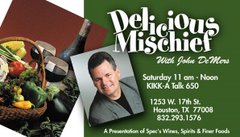SHOW & RECIPE FOR SEPT. 29
OF COURSE IT’S GREEK TO ME
One of our favorite weekends of this or any other year, the first one in October, is right around the corner. For today’s show, we go into the kitchen with Houston’s own Greek community, perhaps even lending a hand in their Herculean effort to feed the multitudes during the annual Greek Festival. There is this notion going around that if you attend the wonderful fest filled with food, wine, music and art, you too can be Greek for the day. That sounds good, naturally, but we think it’s even better that our own very real Greek-Americans work hard all year to make this festival their gift to the community.
WINES FROM THE ANCIENTS
In honor of this year’s Greek Festival, we sit down for a tasting with Greek wine importer Konstantine Drougos. Most people who like wine can guess the ancient Greeks pioneered a lot of techniques for making the stuff 2,000 or even 3,000 years ago. On the other hand, says Konstantine, in recent years the reputation of wines from Greece has suffered from cheap imports and a lot of confusion with things like retsina and ouzo. Our guy is a man with a mission: share some of the best wines now being produced in Greece with a world unlikely to know they exist.
THE ROOM THAT FRED BUILT
Our friend Kevin Simon, who teaches courses in wine at the University of Houston’s hotel and restaurant management program, takes us into his building’s brand-new boardroom filled with wines you just don’t see very often. Thanks to the bequest of Houston attorney (and wine lover) Fred Parks, there’s a new meeting space available to the public, blending wines 50, 75 or even 100 years old with all the latest audio and video technology. We‘ll make it clear to Kevin, however, that lifting a glass may be about as technical as we are likely to get.
This Week’s Delicious Mischief Recipe…
COUSCOUS MARRAKESH
1 pound uncooked couscous
1 cup cold water
1 tablespoon salt
1 cup coarsely chopped onions
1 teaspoon ground coriander
1 tablespoon salt
1 teaspoon crushed red pepper
½ teaspoon ground saffron
1 teaspoon ground cumin
¼ cup peanut oil
2 ½ pounds boneless lamb, cut in 2-inch cubes
2 quarts water
1 (3-pound) chicken, cut into 8 pieces
1 pound carrots, peeled and cut in 1-inch pieces
2 green bell peppers, cut in ½-inch strips
1 pound tomatoes, cut in 1-inch wedges
1 pound yellow squash, peeled and cut in 2-inch slices
12 ounces frozen string beans (regular cut)
1 cup chickpeas (garbanzos)
½ pound black raisins
Salt and black pepper
Parsley sprigs
Moisten the couscous in a 3-quart bowl with the 1 cup of water, to which 1 tablespoon of salt has been added. Stir up with a fork and allow to stand 10 minutes to swell. Spread the couscous out in a colander lined with cheese cloth (or in the top of a couscousiere). Place the colander over a pan that fits it and is half filled with water. Cover with aluminum foil and allow to steam for 10 minutes. In a 6-quart kettle (or bottom of couscousiere), sauté the onions, coriander, salt, crushed red pepper, saffron and cumin in the oil until soft but not brown. Add the lamb and 2 quarts water. Fit the colander (or top of couscousiere) with the steamed couscous over the meat, cover it with foil, and allow mixture to simmer gently for 30 minutes.
Add the chicken to the stew and continue cooking for 30 minutes longer. Stir the couscous from time to time to make sure the grains are separated. Add the carrots, green peppers, tomatoes, squash, string beans, chickpeas and raisins. Season to taste with salt and pepper. Cook for about 15 minutes, or until vegetables are soft but still slightly crisp. Pour the couscous into a large (15- to 18-inch) round serving platter. Make a large hole in the center, pushing the couscous to the edge of platter. Arrange meat and vegetables attractively in center, pouring the sauce over all. Garnish with the parsley sprigs. Serves 8.
Note: A couscousiere is a large double boiler with holes in the bottom of the upper pot that allow its contents to steam. A couscousiere may be improvised by lining a metal colander with cheese cloth and placing the colander in a 6- or 8-quart pot so that the handles rest on the rim. A piece of heavy-duty foil can serve as a lid.

No comments:
Post a Comment